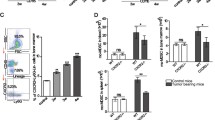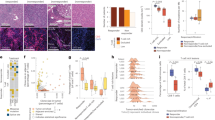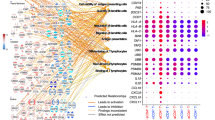Abstract
Dendritic-cell (DC) trafficking and function in tumors is poorly characterized, with studies confined to myeloid DCs (DC1s). Tumors inhibit DC1 migration and function, likely hindering specific immunity. The role of plasmacytoid DCs (DC2s) in tumor immunity is unknown. We show here that malignant human ovarian epithelial tumor cells express very high levels of stromal-derived factor-1, which induces DC2 precursor (preDC2) chemotaxis and adhesion/transmigration, upregulates preDC2 very late antigen (VLA)-5, and protects preDC2s from tumor macrophage interleukin-10–induced apoptosis, all through CXC chemokine receptor-4. The VLA-5 ligand vascular-cell adhesion molecule-1 mediated preDC2 adhesion/transmigration. Tumor preDC2s induced significant T-cell interleukin-10 unrelated to preDC2 differentiation or activation state, and this contributed to poor T-cell activation. Myeloid precursor DCs (preDC1s) were not detected. Tumors may weaken immunity by attracting preDC2s and protecting them from the harsh microenvironment, and by altering preDC1 distribution.
This is a preview of subscription content, access via your institution
Access options
Subscribe to this journal
Receive 12 print issues and online access
$209.00 per year
only $17.42 per issue
Buy this article
- Purchase on Springer Link
- Instant access to full article PDF
Prices may be subject to local taxes which are calculated during checkout




Similar content being viewed by others
References
Cella, M. et al. Plasmacytoid monocytes migrate to inflamed lymph nodes and produce large amounts of type I interferon. Nature Med. 5, 919–923 (1999).
Rissoan, M.C. et al. Reciprocal control of T helper cell and dendritic cell differentiation. Science 283, 1183–1186 (1999).
Nestle, F.O. et al. Vaccination of melanoma patients with peptide- or tumor lysate-pulsed dendritic cells. Nature Med 4, 328–332 (1998).
Holtl, L. et al. CD83+ blood dendritic cells as a vaccine for immunotherapy of metastatic renal-cell cancer. Lancet 352, 1358 (1998).
Hsu, F.J. et al. Vaccination of patients with B-cell lymphoma using autologous antigen- pulsed dendritic cells. Nature Med 2, 52–58 (1996).
Gabrilovich, D.I., Corak, J., Ciernik, I.F., Kavanaugh, D. & Carbone, D.P. Decreased antigen presentation by dendritic cells in patients with breast cancer. Clin. Cancer Res. 3, 483–490 (1997).
Gabrilovich, D. et al. Vascular endothelial growth factor inhibits the development of dendritic cells and dramatically affects the differentiation of multiple hematopoietic lineages in vivo. Blood 92, 4150–4166 (1998).
Menetrier-Caux, C. et al. Inhibition of the differentiation of dendritic cells from CD34+ progenitors by tumor cells: role of interleukin-6 and macrophage colony-stimulating factor. Blood 92, 4778–4791 (1998).
Chomarat, P., Banchereau, J., Davoust, J. & Palucka, A. K. IL-6 switches the differentiation of monocytes from dendritic cells to macrophages. Nature Immunol. 1, 510–514 (2000).
Bell, D. et al. In breast carcinoma tissue, immature dendritic cells reside within the tumor, whereas mature dendritic cells are located in peritumoral areas. J. Exp. Med. 190, 1417–1426 (1999).
Grouard, G. et al. The enigmatic plasmacytoid T cells develop into dendritic cells with interleukin (IL)-3 and CD40-ligand. J. Exp. Med. 185, 1101–1111 (1997).
Kohrgruber, N. et al. Survival, maturation, and function of CD11c- and CD11c+ peripheral blood dendritic cells are differentially regulated by cytokines. J. Immunol. 163, 3250–3259 (1999).
Cella, M., Facchetti, F., Lanzavecchia, A. & Colonna, M. Plasmacytoid dendritic cells activated by influenza virus and CD40L drive a potent Th1 polarization. Nature Immunol. 1, 305–310 (2000).
Kadowaki, N., Antonenko, S., Lau, J. Y.-N. & Liu, Y.-J. Natural interferon α/β-producing cells link innate and adaptive immunity. J. Exp. Med. 192, 219–225 (2000).
Siegal, F.P. et al. The nature of the principal type 1 interferon-producing cells in human blood. Science 284, 1835–1837 (1999).
Banchereau, J. & Steinman, R.M. Dendritic cells and the control of immunity. Nature 392, 245–252 (1998).
Rubbert, A. et al. Dendritic cells express multiple chemokine receptors used as coreceptors for HIV entry. J. Immunol. 160, 3933–3941 (1998).
Kellermann, S.A., Hudak, S., Oldham, E.R., Liu, Y.J. & McEvoy, L.M. The CC chemokine receptor-7 ligands 6Ckine and macrophage inflammatory protein-3 β are potent chemoattractants for in vitro- and in vivo-derived dendritic cells. J. Immunol. 162, 3859–3864 (1999).
Foti, M. et al. Upon dendritic cell (DC) activation chemokines and chemokine receptor expression are rapidly regulated for recruitment and maintenance of DC at the inflammatory site. Int. Immunol. 11, 979–986 (1999).
Dieu, M.C. et al. Selective recruitment of immature and mature dendritic cells by distinct chemokines expressed in different anatomic sites. J. Exp. Med. 188, 373–386 (1998).
Jahnsen, F.L. et al. Experimentally induced recruitment of plasmacytoid (CD123high) dendritic cells in human nasal allergy. J. Immunol. 165, 4062–4068 (2000).
Roers, A., Hochkeppel, H.K., Horisberger, M.A., Hovanessian, A. & Haller, O. MxA gene expression after live virus vaccination: a sensitive marker for endogenous type I interferon. J. Infect. Dis. 169, 807–813 (1994).
Ito, T. et al. A CD1a+/CD11c+ subset of human blood dendritic cells is a direct precursor of Langerhans cells. J. Immunol. 163, 1409–1419 (1999).
Pulendran, B. et al. Flt3-ligand and granulocyte colony-stimulating factor mobilize distinct human dendritic cell subsets in vivo. J. Immunol. 165, 566–572 (2000).
Zou, W. et al. Quantification of cytokine gene expression by competitive PCR using a colorimetric assay. Eur. Cytokine Netw. 6, 257–264 (1995).
Coulomb-L'Hermin, A. et al. Stromal cell-derived factor 1 (SDF-1) and antenatal human B cell lymphopoiesis: expression of SDF-1 by mesothelial cells and biliary ductal plate epithelial cells. Proc. Natl. Acad. Sci. USA 96, 8585–90 (1999).
Rollins, B. J. Chemokines. Blood 90, 909–28 (1997).
Tilton, B. et al. Signal transduction by CXC chemokine receptor 4. Stromal cell-derived factor 1 stimulates prolonged protein kinase b and extracellular signal-regulated kinase 2 activation in T lymphocytes. J. Exp. Med. 192, 313–324 (2000).
Tillman, B.W. et al. Maturation of dendritic cells accompanies high-efficiency gene transfer by a CD40-targeted adenoviral vector. J. Immunol. 162, 6378–6383 (1999).
Mayordomo, J.I. et al. Bone marrow-derived dendritic cells pulsed with synthetic tumour peptides elicit protective and therapeutic antitumour immunity. Nature Med. 1, 1297–1302 (1995).
Rabinowich, H. et al. Expression of cytokine genes or proteins and signaling molecules in lymphocytes associated with human ovarian carcinoma. Int. J. Cancer 68, 276–284 (1996).
Beatty, P., Hanisch, F.G., Stolz, D.B., Finn, O.J. & Ciborowski, P. Biochemical characterization of the soluble form of tumor antigen MUC1 isolated from sera and ascites fluid of breast and pancreatic cancer patients. Clin. Cancer Res. 7, 781s–787s (2001).
Olweus, J. et al. Dendritic cell ontogeny: a human dendritic cell lineage of myeloid origin. Proc. Natl. Acad. Sci. USA 94, 12551–1256 (1997).
Sallusto, F. et al. Distinct patterns and kinetics of chemokine production regulate dendritic cell function. Eur J. Immunol. 29, 1617–1625 (1999).
Geijtenbeek, B.H.T. DC-SIGN-ICAM-2 interaction mediates dendritic cell trafficking. Nature Immunol. 1, 353–357 (2000).
Campbell, J. J. et al. Chemokines and the arrest of lymphocytes rolling under flow conditions. Science 279, 381–4 (1998).
Peled, A. et al. The chemokine SDF-1 activates the integrins LFA-1, VLA-4, and VLA-5 on immature human CD34+ cells: role in transendothelial/stromal migration and engraftment of NOD/SCID mice. Blood 95, 3289–3296 (2000).
Enk, A. H., Jonuleit, H., Saloga, J. & Knop, J. Dendritic cells as mediators of tumor-induced tolerance in metastatic melanoma. Int. J. Cancer 73, 309–316 (1997).
Kiertscher, S.M., Luo, J., Dubinett, S.M. & Roth, M.D. Tumors promote altered maturation and early apoptosis of monocyte-derived dendritic cells. J. Immunol. 164, 1269–1276 (2000).
Marrack, P., Kappler, J. & Mitchell, T. Type I interferons keep activated T cells alive. J. Exp. Med. 189, 521–530 (1999).
Zou, W. et al. Reciprical regulation of plasmacytoid dendritic cells and monocytes during viral infection. Eur.J. Immunol. (in the press).
Groux, H., Bigler, M., de Vries, J.E. & Roncarolo, M.G. Inhibitory and stimulatory effects of IL-10 on human CD8+ T cells. J. Immunol. 160, 3188–3193 (1998).
Nanki, T. & Lipsky, P.E. Cutting edge: stromal cell-derived factor-1 is a costimulator for CD4+ T cell activation. J. Immunol. 164, 5010–5014 (2000).
Muller, A. et al. Involvement of chemokine receptors in breast cancer metastasis. Nature 410, 50–56 (2001).
Zou, W. et al. Macrophage-derived dendritic cells have strong Th1-polarizing potential mediated by β-chemokines rather than IL-12. J. Immunol. 165, 4388–4396 (2000).
Berard, F. et al. Cross-priming of naive CD8 T cells against melanoma antigens using dendritic cells loaded with killed allogeneic melanoma cells. J. Exp. Med. 192, 1535–1544 (2000).
Zou, W. et al. A Guide to isolation, culture and propagation of dendritic cells. in Dendritic Cells: Biology and Clinical Applications, 2nd edn. (ed. Lotze, M.) 77 (Academic Press, London, 2001).
Acknowledgements
We thank O. Haller for antibody against MxA; A. Amara and F. Arenzana-Seisdedos for monoclonal antibody K15C against SDF-1; and S. Clayton, E. Kraus, S. Coquery, C. Chalouni and D. Olivares for technical assistance. T.J.C. was supported by grants from the NIH, the Baylor endowment and Golfers against Cancer. D.E., V.M. and P.G. were supported by the Association de Recherche sur le Cancer (ARC), France.
Author information
Authors and Affiliations
Corresponding authors
Rights and permissions
About this article
Cite this article
Zou, W., Machelon, V., Coulomb-L'Hermin, A. et al. Stromal-derived factor-1 in human tumors recruits and alters the function of plasmacytoid precursor dendritic cells. Nat Med 7, 1339–1346 (2001). https://doi.org/10.1038/nm1201-1339
Received:
Accepted:
Issue Date:
DOI: https://doi.org/10.1038/nm1201-1339
This article is cited by
-
The complex role of IL-10 in malignant ascites: a review
Cancer Immunology, Immunotherapy (2024)
-
Heterogeneity and treatment landscape of ovarian carcinoma
Nature Reviews Clinical Oncology (2023)
-
Immunobiology of high-grade serous ovarian cancer: lessons for clinical translation
Nature Reviews Cancer (2022)
-
Deciphering the immunosuppressive tumor microenvironment in ALK- and EGFR-positive lung adenocarcinoma
Cancer Immunology, Immunotherapy (2022)
-
Enhancing CAR-T cell efficacy in solid tumors by targeting the tumor microenvironment
Cellular & Molecular Immunology (2021)



